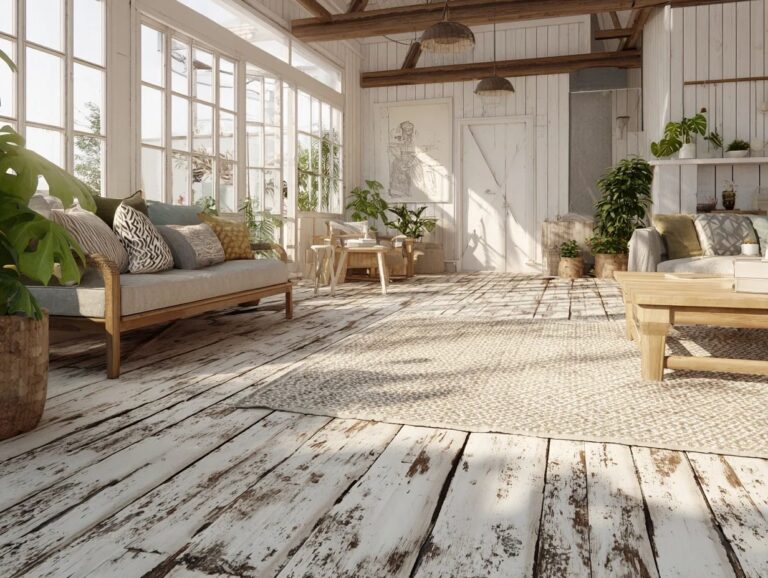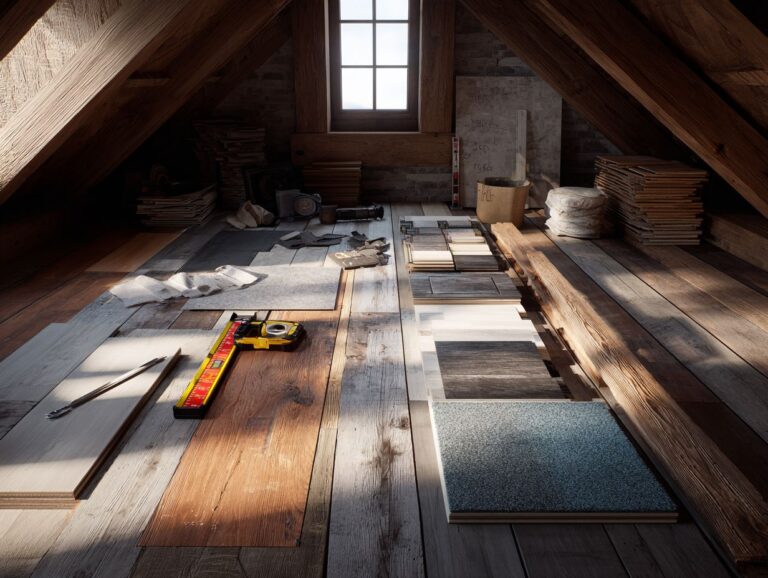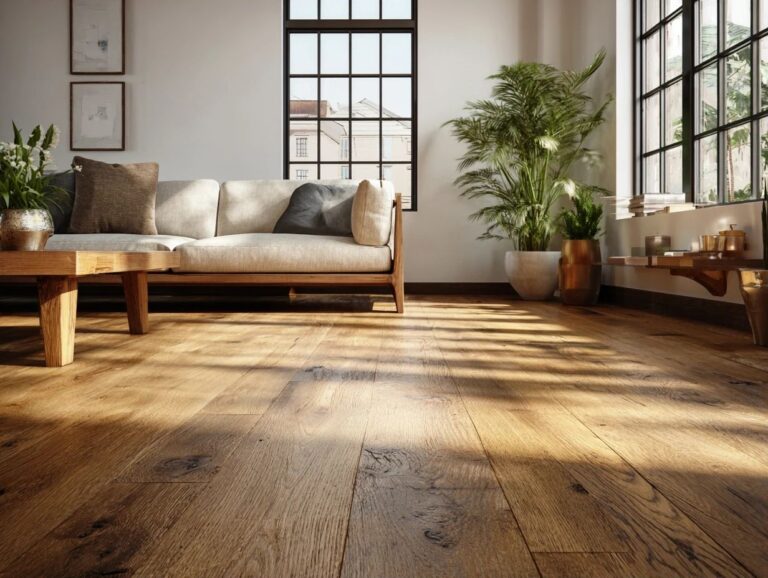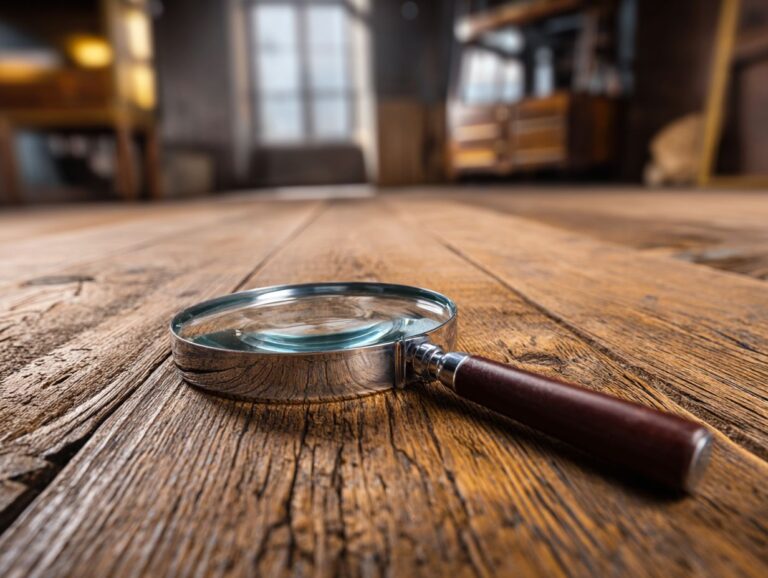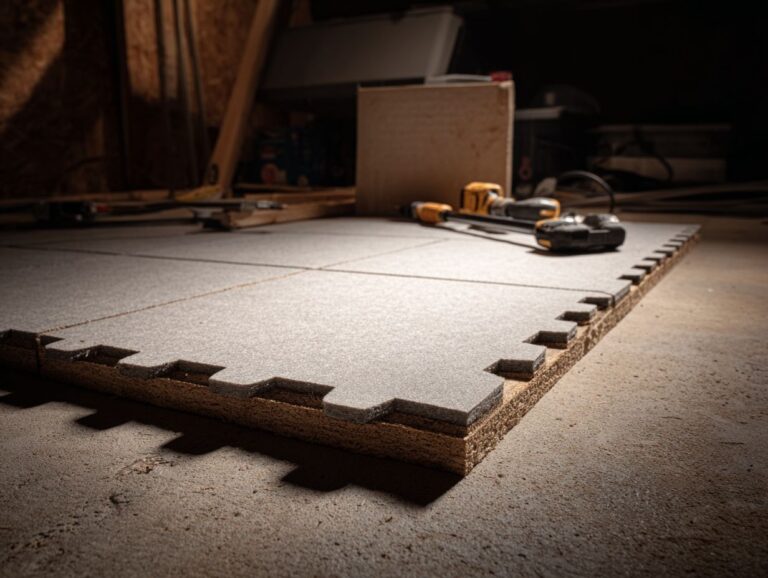Flooring Water Damage – Emergency Response Guide
Contents
- Introduction to Flooring Water Damage
- Water Damage Statistics
- Assessing the Situation
- Immediate Response Steps
- Water Extraction Techniques
- Drying and Dehumidification
- Restoration and Repair
- Preventative Measures
- Frequently Asked Questions
- What should I do in the event of flooring water damage?
- How long does it take to repair flooring water damage?
- Can flooring water damage lead to mold growth?
- Will my insurance cover the cost of flooring water damage restoration?
- What type of damage can occur to flooring from water damage?
- Should I attempt to clean up flooring water damage on my own?
Introduction to Flooring Water Damage
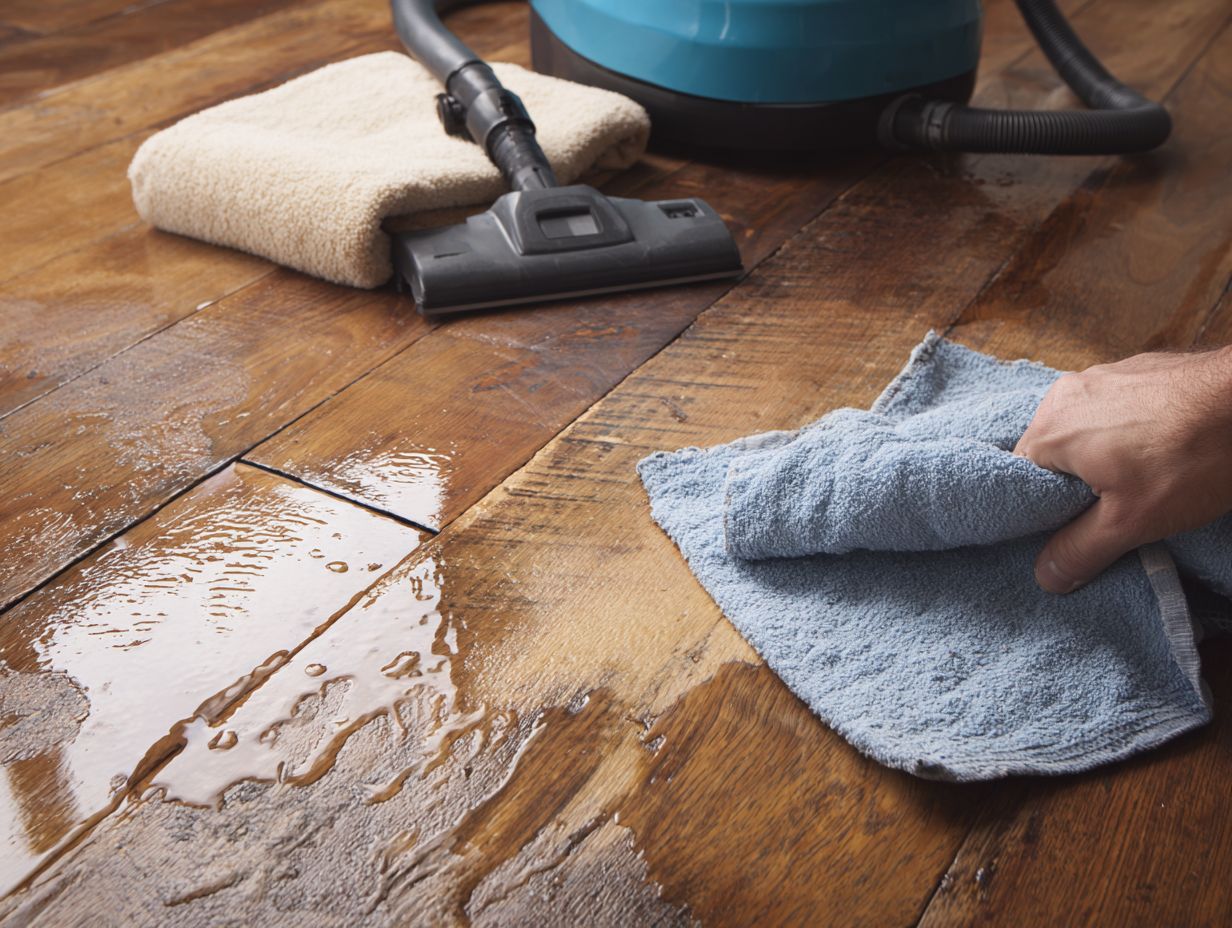
Key Takeaways:
Understanding Water Damage
Water damage involves problems caused by too much moisture, which can harm the structure and appearance of homes.
There are three primary categories of water damage: clean, gray, and black water.
- Clean water originates from sources like broken pipes.
- Gray water may contain soap or detergent from sinks and showers.
- Black water, which includes sewage, poses serious health risks.
Knowing these differences is important, as they greatly affect repair costs, which can be about $3,000 on average.
To assess the damage, use moisture meters. These devices measure moisture levels accurately, enabling the correct repair methods to be applied effectively.
Water Damage Statistics
Water Damage Statistics
Water Damage Overview: Insurance Claims for Water Damage
Water Damage Overview: Flood Damage Costs
Water Damage Overview: Water Damage Incidence
Water Damage Overview: Flood Risk Perception
The Water Damage Statistics give a detailed overview of the financial costs and commonness of water-related damages affecting homeowners. This data is essential for knowing how much damage has occurred and for guiding safety steps or possible insurance requirements.
Insurance Claims for Water Damage show significant figures, with 25% of home insurance claims filed from 2018 to 2022 being related to water damage. In 2022, claims specifically for water damage or freezing comprised 27.6%, emphasizing its commonality. The average insurance payout of $13,954 highlights the considerable financial burden these incidents can cause. It is important for homeowners to have enough insurance and take steps to prevent problems.
Flood Damage Costs reveal substantial economic impacts, with annual costs reaching $180 billion. Notably, even 1 inch of water can lead to $25,000 in damages “”, showing the serious effects of small floods. This data stresses the need for effective flood-prevention strategies and awareness among homeowners.
- Water Damage Incidence: Only 1.6% of homes filed claims from 2018-2022, yet 98% of basements experience water damage at some point. This indicates widespread vulnerability, especially in basements, which often lack adequate preventive infrastructure. Household water leaks usually average 10,000 gallons, pointing to common maintenance issues that can lead to substantial damage over time.
- Flood Risk Perception: Despite the prevalence, only 22% of homeowners in 2023 were aware of flood risks, with 20% believing themselves susceptible. This disparity suggests a disconnect between actual risk and perceived vulnerability, highlighting the need for education and improved risk communication.
The Water Damage Statistics Highlight the common effects and expenses related to water damage, including regular insurance claims and substantial repair bills caused by floods. They reveal a critical need for increased awareness and proactive measures to mitigate damage, especially in flood-prone areas. Homeowners should be educated on risks and prevention strategies, ensuring financial protection and safety against potential water damage.
Common Causes of Water Damage
The leading causes of water damage include faulty plumbing fixtures, leaky roofs, and overflows from household appliances.
To mitigate these risks, homeowners can adopt specific preventative measures.
- For plumbing leaks, regular inspections and using pipe insulation can significantly reduce the risk.
- Fixing roof leaks means scheduling expert checks, particularly after severe storms, to make sure all shingles and seals are in good condition.
- To prevent HVAC system failures, it’s advisable to change filters regularly and schedule annual maintenance.
- In regions like Chicago, investing in sump pumps can guard against heavy rainfall flooding.
- Ensuring gutters and downspouts are clear promotes proper drainage away from the foundation, protecting basements from water intrusion. For more comprehensive insights on maintaining the integrity of your flooring, consider reading our guide on subfloor damage assessment and repair.
Assessing the Situation
It’s important to carefully check how bad the water damage is to know how to fix it.
Identifying the Source of Water

Finding where the water is coming from is the first important step to reduce damage and stop more problems.
To effectively trace water leaks, begin with a thorough visual inspection of plumbing fixtures, including under sinks and behind appliances.
Use moisture meters to detect hidden leaks in walls, or consider installing water sensors that alert you to leaks in real-time.
For example, one homeowner identified a slow leak behind their washing machine, which had gone unnoticed for months, leading to significant water damage. After finding the problem, they quickly changed the broken hose and put in sensors to stop any problems from happening again. This proactive approach can save thousands in repairs.
Evaluating the Extent of Damage
To correctly assess the level of damage, check the moisture levels and look for physical harm to the flooring.
To assess moisture levels, use a moisture meter like the General Tools MMD4E, which costs around $30. This device helps identify hidden water damage in hardwood floors.
Next, look for visible signs of physical damage; note any warping, buckling, or discoloration, which indicate long-term exposure to moisture.
When you’ve gathered this information, compare the moisture readings with the manufacturer’s acceptable levels to determine if replacement is necessary or if repairs will suffice. Document your findings to support any insurance claims.
Safety Precautions
Implementing safety precautions is critical when dealing with water damage to avoid health risks and further complications.
Start by wearing essential safety gear, including gloves and masks, to prevent exposure to contaminants.
Before going into any impacted area, make sure electrical systems are safe by turning off the power.
Next, inspect for mold growth, as it can pose serious health risks; if mold is present, consider hiring a professional.
Also, have a list of emergency contacts on hand, such as local repair companies and healthcare providers, for quick help.
This proactive approach will help you manage the situation more effectively.
Immediate Response Steps
Acting quickly can greatly lessen water damage and related expenses, so it’s important to act fast.
Shutting Off Water Supply
The very first step in an emergency is to shut off the water supply to prevent further damage.
To locate the main water supply valve, follow these steps:
- In single-family homes, look in the basement or crawl space near where the water line enters the house.
- For condos, it’s often next to the washing machine or in a closet.
- In some older homes, the valve may be outside near the street.
- Use a wrench to turn the valve clockwise until it stops.
- If you encounter resistance, apply penetrating oil to ease the movement.
- Always familiarize yourself with its location during routine maintenance to act quickly in emergencies.
Evacuating Affected Areas
Leaving areas in danger keeps people safe and helps manage damage effectively.
To execute a safe evacuation, prioritize communication and preparedness. Begin by informing all occupants through clear announcements and texts containing emergency contacts.
Provide everyone with essential safety items, such as first aid kits, water, and flashlights.
Pick a secure place to gather and check that everyone is there when you arrive. If you have time, gather your belongings and shut off utilities.
By staying calm and organized, you can greatly lower risks and improve the evacuation process.
Documenting Damage
Recording damage is important for insurance claims and later repair work.
To accurately document damage, begin by taking clear photos from various angles, ensuring all damaged areas are visible.
Next, create a detailed list of damaged items, including descriptions, quantities, and estimated values.
Note environmental conditions that may have contributed to the damage; for instance, record humidity levels if flooding occurred.
This detailed documentation helps with your insurance claim and shows repair costs, simplifying discussions with contractors and insurers.
Water Extraction Techniques
Using the right methods to remove water is very important to stop lasting harm to hardwood floors.
Using Wet/Dry Vacuums
Using a wet/dry vacuum can be an effective method for homeowners to extract standing water quickly.
To begin, select a dependable model like the Shop-Vac 5989300, which costs about $99 and is known for its strong suction ability.
Begin by ensuring the vacuum is set to the wet setting, then remove any filters that may be damaged by water.
When vacuuming, move slowly to allow the machine to pick up maximum water while avoiding any electrical hazards. Always wear rubber gloves and boots for safety.
For larger jobs, consider a vacuum with at least 5 horsepower for better efficiency in handling hefty water volumes.
Employing Professional Water Extraction Services
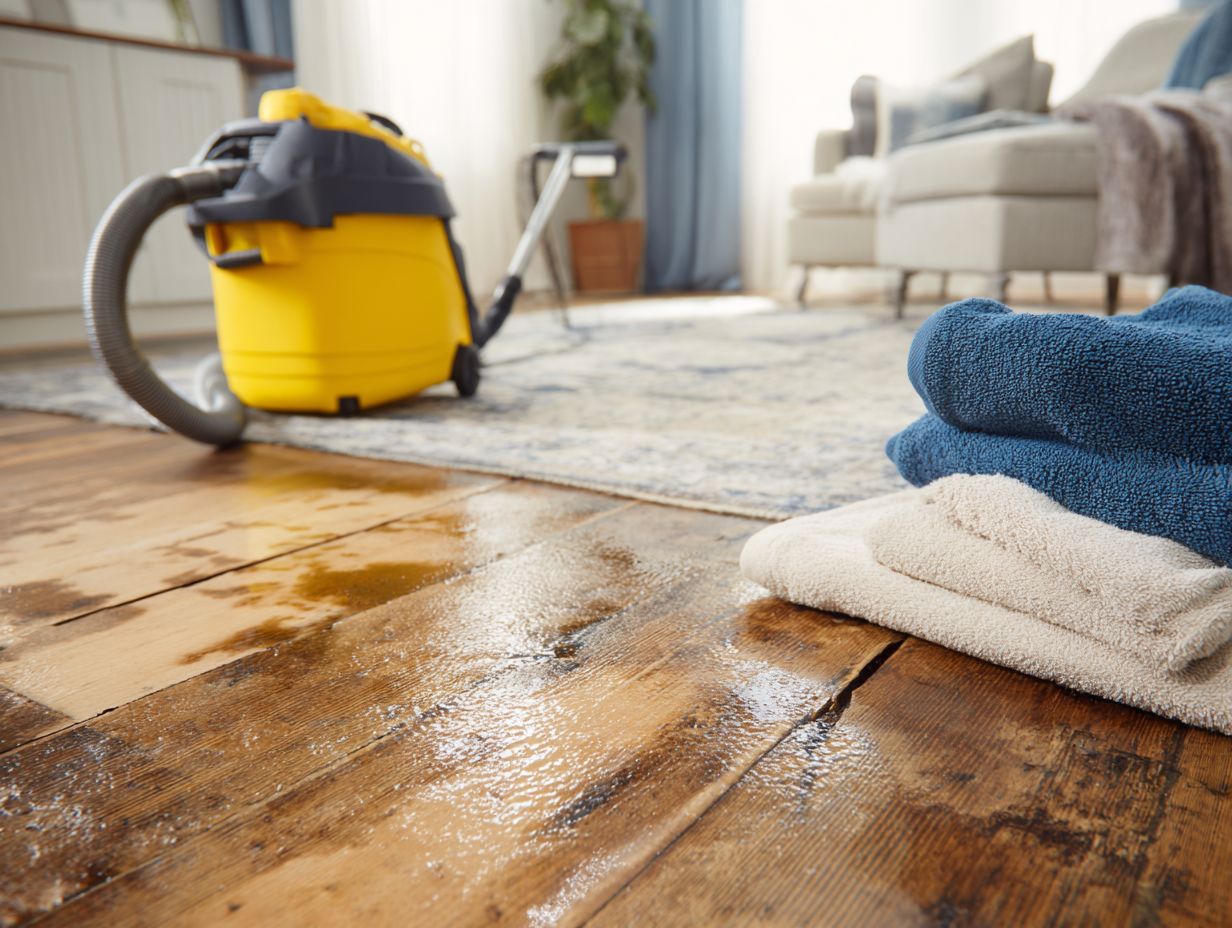
For extensive water damage, hiring experts in water extraction can make sure water is removed completely and quickly.
Consider reputable local services like All Dry Services, Big Bear Restoration, or SERVPRO, which typically charge between $200 and $400 for an initial assessment.
Getting professional help is important when handling serious damage. These specialists use top-quality tools for faster water removal and to stop mold from forming.
Experts offer helpful advice on needed repairs, which might prevent expensive problems later.
Evaluate your situation carefully; if water remains after DIY efforts, it’s time to call in the specialists.
Drying and Dehumidification
Drying is important for fixing hardwood floors and stopping mold after water damage.
Importance of Proper Drying
Proper drying is critical to maintaining the structural integrity of hardwood floors and preventing mold growth.
Ideally, wood should be dried within 48 hours to keep moisture levels below 20%. This limit is important because higher moisture can result in a 60% higher chance of mold growing.
Using a moisture meter can give exact readings, while a dehumidifier helps dry things faster. Aim for a humidity level of 30-50% in the drying area.
Regularly monitoring these factors can reduce mold risk by up to 80%, safeguarding both the wood’s quality and your indoor air environment.
Methods for Effective Drying
Utilizing effective drying methods, such as dehumidifiers and air movers, is essential for expediting the drying process.
For example, try using a Frigidaire 70-Pint dehumidifier, which costs about $249 and effectively lowers humidity levels.
Use commercial air movers, such as the Lasko High-Velocity Fan, to increase airflow and help moisture dry faster.
Check moisture levels often with a moisture meter like the General Tools MMD4E, which is priced around $20, to make sure the area dries properly.
Using these methods guarantees a complete and effective drying process, reducing chances of mold and structural damage.
Restoration and Repair
Bringing back and fixing hardwood floors is essential to make them look as they did before after being damaged by water.
Assessing Repair Needs
Assessing repair needs involves determining which components of the flooring must be repaired or replaced.
Start by checking for warped boards, which can often indicate underlying moisture issues. Inspect the subfloor for signs of rot or mold, which can compromise the integrity of your flooring.
Look for discoloration, as this may suggest water damage or sun exposure. A moisture meter gives exact measurements; repairing the problem usually takes one to three days depending on how bad the damage is.
Document your findings to prioritize which areas require immediate attention and set a budget for repairs.
Choosing the Right Flooring Material
Picking the right flooring material during renovation is important to prevent expensive replacements later.
Two primary options to consider are engineered hardwood and solid hardwood.
Engineered hardwood is made of several wood layers, which makes it good at resisting water. This makes it suitable for use in basements and kitchens. It typically costs between $3 to $10 per square foot, which can save you money in moisture-prone areas.
Solid hardwood, while beautiful, is more expensive (around $5 to $15 per square foot) and susceptible to warping. For a cost-effective choice that balances aesthetics and durability, engineered hardwood is a wise investment for many homeowners.
Professional vs. DIY Repairs
Deciding between professional repairs and DIY methods can impact both the quality and cost of restoration.
When evaluating your options, consider the specific repair needed.
For minor fixes, like patching drywall or changing a faucet, DIY can be cost-effective. Tools like a stud finder or plumbing wrench can help with your work.
For challenging tasks such as electrical wiring or major plumbing problems, it’s wise to hire an expert due to safety regulations and required skills. An electrician with a license can follow the rules, which might help you avoid expensive errors.
Assess your skills, budget, and the project’s complexity to determine the best approach.
Preventative Measures
You need to prevent water from damaging your hardwood floors.
Regular Maintenance Tips
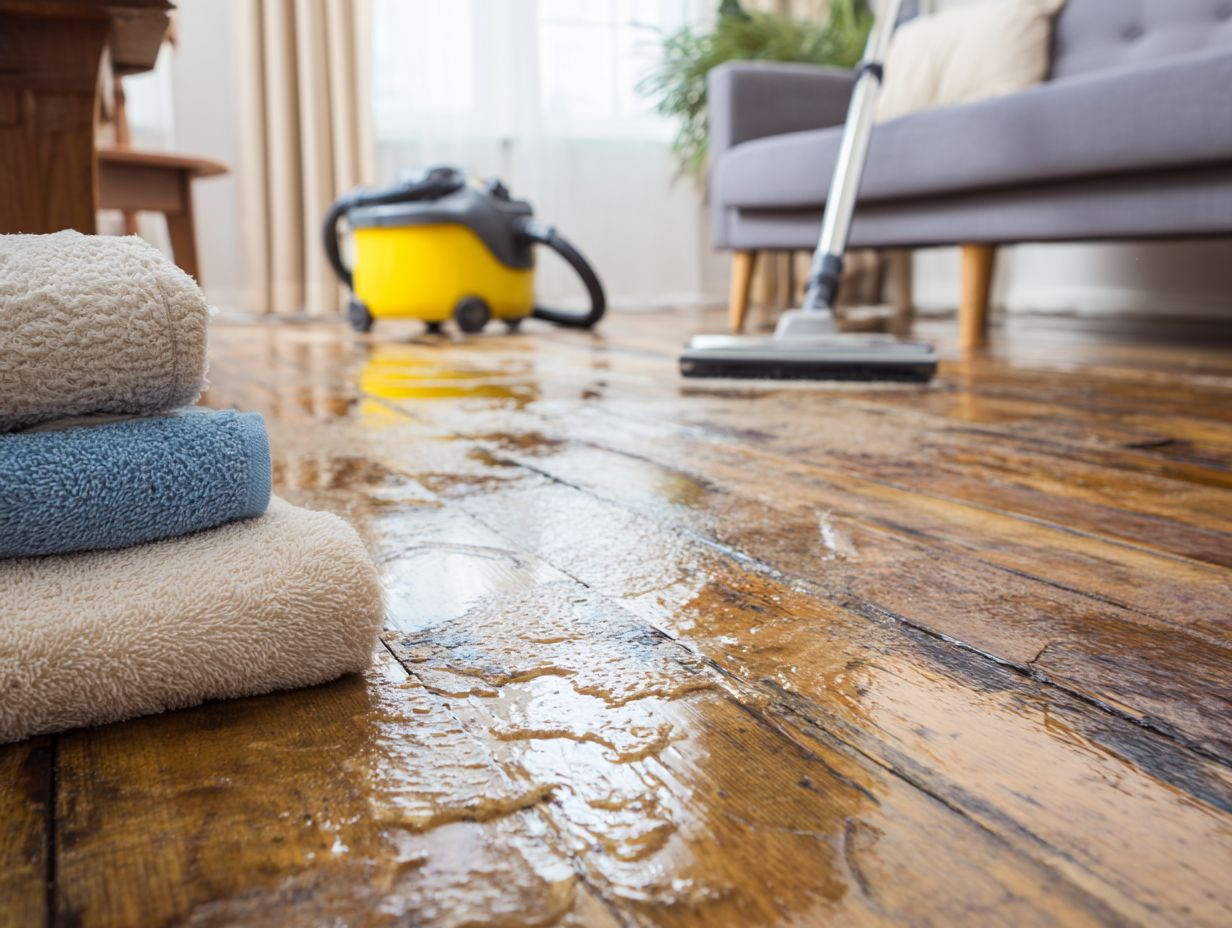
Regular maintenance is key to preventing water damage and ensuring the longevity of your hardwood floors.
To maintain hardwood floors, inspect your plumbing for leaks twice a year.
In spring and fall, clean out your gutters to remove leaves and other debris. Make sure water flows away from your home’s foundation.
Monitor indoor humidity levels, ideally keeping them between 30-50%. A dehumidifier or humidifier can help manage fluctuations.
Regularly sweep and mop your floors with a pH-neutral cleaner to prevent dirt build-up and scratches, ensuring their beauty and integrity for years to come.
Installing Water Detection Systems
Installing water detection systems significantly reduces the risk of undetected water damage in homes.
The Honeywell Lyric Wi-Fi Water Leak Detector, priced at $79, notifies homeowners about water leaks via messages on their smartphones. This system connects smoothly with other connected home devices for better monitoring.
Another strong contender is the Aqara Water Leak Sensor, which functions well within the broader Aqara ecosystem, providing real-time alerts and costing around $30.
Research indicates that homes with these detectors usually have lower repair expenses, so regularly checking them is a wise decision to avoid surprise water issues.
Frequently Asked Questions
What should I do in the event of flooring water damage?
If you experience flooring water damage, the first step is to turn off the water source to prevent any additional damage. Then, call a reliable company that specializes in water damage immediately for assistance. They will have the right tools and skills to remove the water and prevent more damage.
How long does it take to repair flooring water damage?
The timeframe for repairing flooring water damage depends on the extent of the damage. In most cases, it can take anywhere from a few days to a few weeks. A professional restoration company can provide a more accurate estimate after assessing the damage.
Can flooring water damage lead to mold growth?
Yes, if the water damage is not properly treated and dried, it can lead to mold growth. Mold can start to grow within 24-48 hours after water damage occurs. It is important to address flooring water damage as soon as possible to prevent mold growth and potential health hazards.
Will my insurance cover the cost of flooring water damage restoration?
This will depend on your specific insurance policy and the cause of the water damage. It is important to review your insurance policy and contact your insurance provider for more information. A professional restoration company can help with the insurance claim process.
What type of damage can occur to flooring from water damage?
Flooring water damage can cause a variety of damages such as warping, buckling, and staining. In severe cases, it can result in having to replace the entire floor. In addition, if the water seeps into the subfloor, it can cause structural damage to the building.
Should I attempt to clean up flooring water damage on my own?
It is not recommended to attempt to clean up flooring water damage on your own. This can be a dangerous and complicated task without the proper equipment and training. It’s best to let experts handle the damage to make sure it’s fixed correctly.
